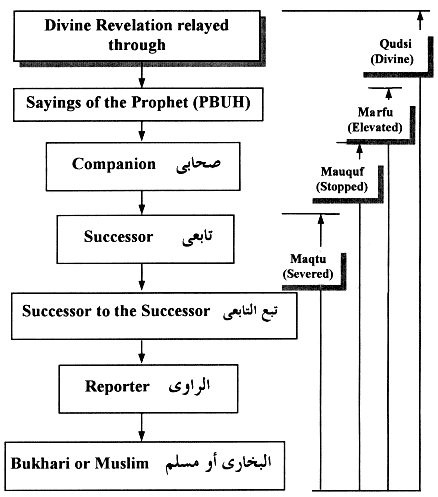
|
Islam, the Arabic word Sunnah has come to denote the way Prophet Muhammad (S), the Messenger of Allah, lived his life. The Sunnah is the second source of Islamic jurisprudence, the first being the Qur’an. Both sources are indispensable; one cannot practice Islam without consulting both of them. The Arabic word hadith (pl. ahadith) is very similar to Sunnah, but not identical. A hadith is a narration about the life of the Prophet (S) or what he approved - as opposed to his life itself, which is the Sunnah as already mentioned. |
|
The explosion of Islam in the 7th and 8th centuries confronted Islamic scholars with a daunting task: to preserve the knowledge of the Sunnah of the Prophet (S). Hence the science of hadith evaluation was born. |
|
Components of Hadith : A hadith is composed of three parts (see the figure [below]): |


|
1) According to the reference to a particular authority
Four types of hadith can be identified.
Qudsi - Divine; a revelation from Allah (SWT); relayed with the words of the Prophet (PBUH). Marfu - elevated; a narration from the Prophet (PBUH), e.g. I heard the Prophet (PBUH) saying ... Mauquf- stopped: a narration from a companion only, e.g., we were commanded to ... Maqtu' - severed: a narration from a successor
It invites his attention to the history of those who purchased the punishment of Hell in exchange for the comforts of this world. It tells him of those who were granted the entry into Paradise for having led a life of purity.
Briefly put, the Qur'an prepares man for attaining salvation both in this world and the next through obedience to the Divine commandments. |

|
3)According to the number of reporters involved in each stage of Isnad
Five categories of hadith can be identified: Mutawatir - Consecutive: is a hadith which is reported by such a large number of people that they cannot be expected to agree upon a lie, all of them together. Ahad - isolated: is a hadith which is narrated by people whose number does not reach that of the mutawatir. It is further classified into: Mash'hur - famous: hadith reported by more than two reporters. Aziz - rare, strong: at any stage in the isnad, only two reporters are found to narrate the hadith. Gharib - strange: At some stage of the Isnad, only one reporter is found relating it. |
|
4)According to the nature of the text and isnad
Munkar - denounced: is a hadith which is reported by a weak narrator, and whose narration goes against another authentic hadith. Mudraj - interpolated: an addition by a reporter to the text of the hadith being narrated. |
|
5)According to the reliability and memory of the reporters
This provides the final verdict on a hadith - four categories can be identified: Sahih - sound. Imam Al-shafi'i states the following requiremetts for a hadith, which is not mutawatir, to be acceptable "each reporter should be trustworthy in his religion; he should be known to be truthtul in his narrating, to understand what he narrates, to know how a different expression can alter the meaning, and to report the wording of the hadith verbatim, not only its meaning". Hasan - good: is the one where its source is known and its reporters are unambiguous. Da'if - weak: a hadith which fails to reach the status of hasan. Usually, the weakness is: a) one of discontinuity in the isnad, in which case the hadith could be - according to the nature of the discontinuity - munqati (broken), mu'allaq (hanging), mu'dal (perplexing), or mursal (hurried), or b) one of the reporters having a disparaged character, such as due to his telling lies, excessive mistakes, opposition to the narration of more reliable sources, involvement in innovation, or ambiguity surrounding his person. Maudu' - fabricated or forged: is a hadith whose text goes against the established norms of the Prophet's sayings, or its reporters include a liar. Fabricated hadith are also recognized by external evidence related to a discrepancy found in the dates or times of a particular incident. |
To Read Books Of Ahadith Click Here
Ahadith
|
Matn (text), isnad (chain of reporters), and taraf (the part, or the beginning sentence, of the text which refers to the sayings, actions or characteristics of the Prophet (PBUH), or his concurrence with others action). The authenticity of the hadith depends on the reliability of its reporters, and the linkage among them. |
|
2)According to the links of Isnad - interrupted or uninterrupted
Six categories can be identified. Musnad - supported: a hadith which is reported by a traditionalist, based on what he learned from his teacher at a time of life suitable for learning; similarly - in turn - for each teacher until the isnad reaches a well known companion, who in turn, reports from the Prophet (PBUH). Mutassil - continuous: a hadith with an uninterrupted isnad which goes back only to a companion or successor. Mursal - hurried: if the link between the successor and the Prophet (PBUH) is missing, e.g. when a successor says "The Prophet said...". Munqati - broken: is a hadith whose link anywhere before the successor (i.e., closer to the traditionalist recording the hadith) is missing. Mu'adal - perplexing: is a hadith whose reporter omits two or more consecutive reporters in the isnad. Mu'allaq - hanging: is a hadith whose reporter omits the whole isnad and quotes the Prophet (PBUH) directly (i.e., the link is missing at the beginning). |




